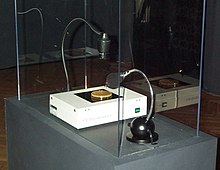Eduardo Kac
Eduardo Kac (born July 3, 1962 in Rio de Janeiro ) is a Brazilian-American artist.
Life
In 1985, he obtained a Bachelor of Arts degree from the School of Communications of the Pontifical Catholic University of Rio de Janeiro . He received his Master of Fine Arts in 1990 from the School of the Art Institute of University of Chicago .
A Ph.D. He graduated from the University of Wales in Great Britain in 2003 . In 1997 he became Assistant Professor of Art and Technology Studies at the School of the Art Institute at the University of Chicago .
Kac is a member of the editorial committee of the journal Leonardo , published by MIT Press . Kac lives and works in Chicago.
Works

As a teenager , he started performing art on the beach in Rio de Janeiro and in the Cinelandia district . He declaimed poems with a hint of pornography, wearing only a pink mini-shirt. He also experimented with graffiti and multimedia art . So he investigated the possibilities of making poetic statements with holograms . In 1983 he published his first holopoem with the title Holo / Olho ( Holo / Auge ), in which the heading of a holographic text changes when the viewer changes his position. In 1984 he made his debut with the digital poem Não! (“No!”) In which a block of text scrolls across an LED display.
With his concept of bio art or transgenic art he tries to manipulate life and life processes or to create new ones. In this way he wants to cross the boundaries between life and non-life, between the natural and the artificial world. With the help of genetically modified organisms, he wants to convey conceptual and symbolic statements.
In 1997 he had a microchip , which is usually used to chip animals, implanted ( Time Capsule project ) and was entered in the database of the company that sells these chips.
In 1998 he began to experiment with the possibilities of transgenic art . Well-known works by him are Genesis (1999 at Ars Electronica in Linz), das Leuchtkaninchen (2000), The Eighth Day (2001) or Cypher (2009 at the Center for Contemporary Art RURART in Rouillé ), in which he uses questions of transgenics with the help of of electronic art.
His work has been exhibited in large parts of the USA, Europe and South America, including at the Leonora Vega Gallery, New York, at Nexus Contemporary Art, Atlanta, the Huntington Art Gallery, Austin, Otso Gallery, Helsinki, Galerie Lara Vincy, Paris, at the St. Petersburg Biennale, in the Museu de Arte Moderna , Rio de Janeiro, and in the InterCommunication Center, Tokyo.
Public collections
- Museum of Modern Art in New York
- Exit Art , New York
- Museu de Arte Moderna in Rio de Janeiro, Brazil
- Museum of Holography in Chicago
- UECLAA - University of Essex , Colchester (England)
Awards
In 1995 he received the Shearwater Foundation Holography Award and in 1998 the Leonardo Award for Excellence . In 2009 he received the Golden Nica in the Hybrid Art category of the Ars Electronica Festival in Linz for Natural History of the Enigma .
literature
- Aleksandra Kostic , Peter Tomaz Dobrila : Eduardo Kac: Teleporting An Unknown State . ISBN 961-6304-00-3 .
- Eduardo Kac: Life Transformation - Art Mutation. Retrieved January 26, 2020.
Web links
- Eduardo Kac's website
- Thomas Dreher: Telepresence - Eduardo Kac and Ken Goldberg
- Thomas Dreher: The Eighth Day - Eduardo Kac
- Eduardo Kac: Life Transformation - Art Mutation. Retrieved January 26, 2020.
- Instituto Itaú Cultural: Eduardo Kac. In: org.br. Enciclopédia Itaú Cultural (Brazilian Portuguese).
- Literature by and about Eduardo Kac in the bibliographic database WorldCat
Individual evidence
- ^ Eduardo Kac on Britannica.com, accessed January 26, 2020.
- ^ Profile of Eduar Kac at the School of the Art Institute of Chicago , accessed January 26, 2020.
- ↑ What Bio Art Is: A Manifesto , accessed January 26, 2020.
- ↑ Andrew Prescott: The Poetics of Technology: Reflections on the Art of Eduardo Kac , May 3, 2018, accessed January 26, 2020.
- ↑ Eduardo Kac "Genesis" , accessed on January 26, 2020.
- ↑ BIO ART Transgenic works and other living pieces , accessed on January 26, 2020.
- ↑ ARS ELECTRONICA ARCHIVE - PRIX , database search.
| personal data | |
|---|---|
| SURNAME | Kac, Eduardo |
| BRIEF DESCRIPTION | Brazilian artist |
| DATE OF BIRTH | 3rd July 1962 |
| PLACE OF BIRTH | Rio de Janeiro |
